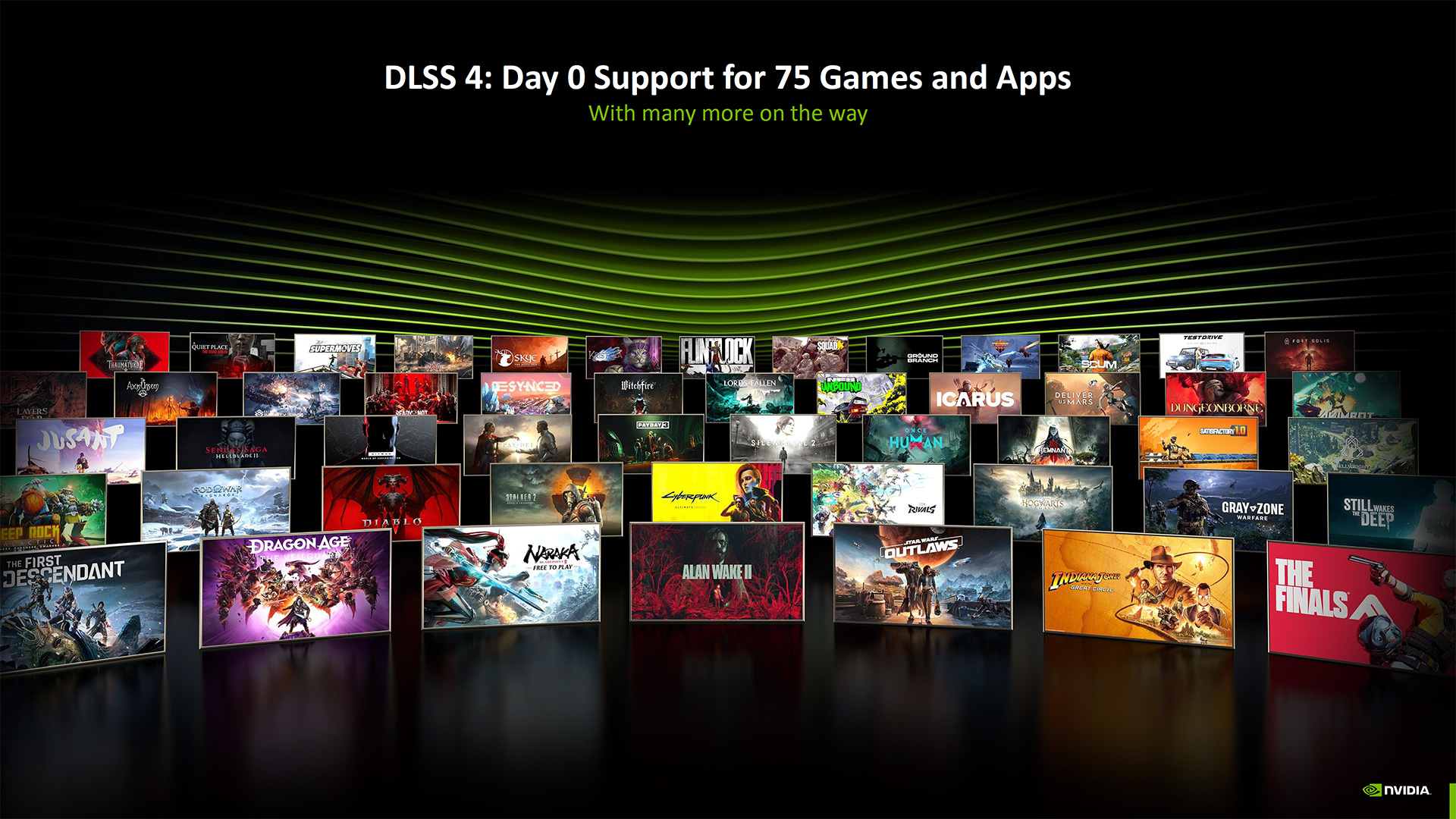Why you can trust Tom’s HardwareOur expert reviewers spend hours testing and comparing products and services so you can choose the best for you.Find out more about how we test.
Nvidia RTX 5070 Founders Edition Full RT and DLSS 4 Testing
Nvidia RTX 5070 Founders Edition Full RT and DLSS 4 Testing (Coming later…)
As we’ve said in other recent reviews, there’s a lot of other testing we want to conduct, but we’ve been short on time for the past month or more it feels like. We’ll run the RTX 5070 and some other GPUs through some games that support DLSS 4 in the coming days, after the 9070-series launch. The tests will be similar to ourDLSS 4, MFG, and full RT 5080 and 5090 benchmarks, but with a few additional games perhaps.We’ll discuss things in more detail once we have more numbers. Until then, here’s the short recap of Multi Frame Generation. It’s a key element in Nvidia’s performance claims for the entire Blackwell family of GPUs, and the results — if taken purely at face value — can be highly misleading.
Above, you’re able to see a video in which Bryan Catanzaro, Nvidia’s VP of Applied Deep Learning Research, discusses the changes to DLSS 4. Some changes only affect the RTX 50-series GPUs while others apply to all RTX cards. DLSS upscaling is one that gets changed for everything with a new Transformers algorithm.The short summary is that DLSS Transformers are more computationally intensive but yield better image quality results. We’ve played around with Cyberpunk 2077 and feel there’s more to this than just marketing hype. Even with the Balanced and Performance modes, DLSS Transformers can still look very good at 4K. It could actually deliver on Nvidia’s “better than native” claims for DLSS.What about Multi Frame Generation is a different can of worms. As the name implies, it generates multiple frames rather than interpolating just one. It can run in three modes: 2X (generate a single frame), 3X (generate two frames), and 4X (generate three frames). In principle, it’s a lot like the original framegen, just with more generated frames.It takes two input images plus motion vectors and depth buffers and works to generate high-quality intermediate frames. In practice, there are some big changes compared to DLSS 3 on the RTX 40-series. MFG runs off the Blackwell tensor cores. We don’t know if that means it can leverage the FP4 number format, but that would make sense. The OFA in the 40-series was a fixed function unit, and Nvidia apparently has reached the point where it can do better framegen via a software algorithm running a new AI model than by the old OFA. The new tensor-based framegen also runs faster than the OFA variant, even on an RTX 40-series GPU (or at least on the RTX 4090).

There are around 75 games and applications that are DLSS 4 enabled, according to Nvidia, either with native support or via Nvidia App overrides. (Nearly all of them are via the Nvidia App right now.) You can use the new DLSS Transformers model to get improved image quality, with a slight hit to performance relative to the previously existing DLSS CNN (Convolutional Neural Network) models but with higher image quality. The performance hit does vary by the generation of hardware, however, and we expect transformers will run quite a bit slower than the CNN model on the 30- and 20-series RTX cards.MFG now has native support in several games, including the latest 2.2.1 Cyberpunk 2077 patch, Alan Wake 2, and Hogwarts Legacy. We still need to test the 5070 Ti (and previous generation cards it replaces), so we’ll hold off on any charts or analysis right now. But what we know of MFG from the 5080 and 5090 suggests it’s not going to be a universal win.In our view, MFG basically needs at least 30 FPS for rendered performance, and 40+ FPS is better, with MFG either doubling, tripling, or quadrupling that. But it does necessarily scale perfectly, often getting more like 75% better for each additional generated frame. At the same time, delays are introduced, and depending on the game, user, and controller of choice, the final result can be better or worse than the non-framegen / non-MFG experience.The resulting output on your monitor generally looks smoother, but it doesn’t necessarily feel that much better. The 5080, for example, got 36 FPS with 4K RT-Overdrive and DLSS Quality Transformers. Turning on MFG bumped that to 66, 95, and 122 FPS, with input sampling happening at 33, 32, and 31 FPS, respectively. That means responsiveness got worse at each level while the frame smoothing got better.What happens with a slower GPU like the RTX 5070 Founders Edition? The starting FPS will be lower, which means it’s more likely to have results where it will need higher levels of upscaling to reach acceptable performance levels. In some cases a game might feel like it’s running worse than before, even though the reported FPS is higher. So, check back and we’ll update this section with more details.
More to come….
Current page:Nvidia RTX 5070 Founders Edition Full RT and DLSS 4 Testing
Jarred Walton is a senior editor at Tom’s Hardware focusing on everything GPU. He has been working as a tech journalist since 2004, writing for AnandTech, Maximum PC, and PC Gamer. From the first S3 Virge ‘3D decelerators’ to today’s GPUs, Jarred keeps up with all the latest graphics trends and is the one to ask about game performance.

